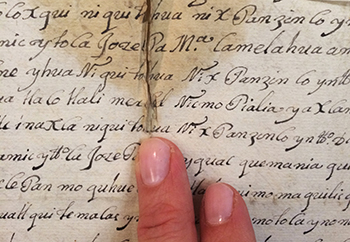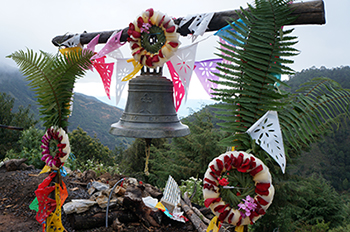About the Project


This project is funded
by the European Union.
Europe and America in Contact: a Multidisciplinary Study of Cross-cultural Transfer in the New World Across Time (CUTLURECONTACT 312795, Starting Grant, European Research Council, 2012-2017; Principal Investigator: Justyna Olko)

A five-year team project is being carried out by the Faculty of “Artes Liberales” together with two partner institutions: the Universidad de Sevilla (Spain) and the Instituto de Docencia e Investigación Etnológica de Zacatecas (Mexico). The project focuses on the systematic study of different forms of cross-cultural transfer between the Nahua and European worlds, as manifested in language and other aspects of culture. Its chronological scope embraces the period from first contact to the present day. This research examines both indigenous (mainly Nahuatl-speaking zone of central Mexico) and parallel Spanish perspectives, including their complementarity, as well as their mutual interactions. An important component is provided by data from the Andean region, linked to cross-cultural contact reflected in the colonial evolution of the Quechua language. This approach allows for a comparative perspective absent in prior research. A systematic analysis of language contact phenomena provides a point of departure for studying other elements of native and European cultures, such as worldview, religious beliefs, ritual, mythology, forms of socio-political and economic organization, social relationships and structure or kinship systems.
A major innovation of this project is to study this process of cross-cultural communication in its full historical depth, through the colonial and postcolonial eras up to the present day and encompassing different stages and types of contact. The long-term cross-cultural contact and resulting transformations reflected in language and other aspects of Nahua culture are by no means terminated processes. Present dialects represent different levels of similarity to older Nahuatl as well as varying degrees of Hispanization whose underlying historical, social and cultural factors remain largely unstudied. Thus, one of the purposes of this project is to bridge this enormous disciplinary, thematic and ideological gap by linking the colonial, contact-induced change to modern phenomena.
On a general level, the aims of the project are to:
- undertake comprehensive research on contact-induced change in the native world on both micro- and macroregional levels, embracing the currently available corpus of indigenous texts
- include Spanish quotidian texts in studies on cross-cultural transfers
- study contact phenomena in the New World as a notably two-sided process in its time depth, aiming to determine the crucial factors and mechanisms of culture change.
The proposed research starts with identifying transfers in language, studied systematically through the creation of extensive databases, but leads to exploring the substance of cross-cultural transfer. Taking into account colonial sources (literary and “mundane” genres of indigenous and Spanish texts) as well as modern data (ethnolinguistic materials gathered during the project’s fieldwork), we explore the processes of translation and interpretation of concepts and terms associated with European/colonial and modern Mexican cultures, especially those related to their religious, legal, political economic and technological aspects. We also strive to understand processes of adaptation of foreign classificatory systems and transformation of local ones. Team members document a broad scope of phenomena associated with cross-cultural transfer, recording and analysing in a systematic way attestations of Spanish loanwords, neologisms, semantic changes in traditional vocabulary, calques, as well as morphological, phonological and syntactic changes. The analysis embraces these same phenomena in sixteenth through eighteenth-century sources and in several selected modern variants of Nahuatl, which have never been compared to the colonial language. Such an approach makes it possible to identify and understand factors of cultural and linguistic change as well as mechanisms of cross-cultural transfer; it also allows us to appreciate and comprehend processes of cultural continuity in conditions of intense contact. Verbal references to the “new” are complemented by the study of pictorial conceptualizations of the Europeans and their world in the rich corpus of native iconographic sources produced between the sixteenth and nineteenth centuries. In this comprehensive reconstruction we also draw on comparative data from the Andean world and its corpus of Quechua texts.
The project is carried out together with scholars and students for whom Nahuatl is the first language as well as with collaborating members from native communities. The methodological innovation of our work transcends the notion of “informants,” seeking an entirely new form of collaboration with native speakers of Nahuatl.
Our approach makes it possible to account for:
- the prolonged period of contact, its intensity and areal distribution
- language change in Nahuatl in terms of the social, political and cultural settings involving such factors as type and degree of bilingualism, degree of urbanization, degree of Christianization, strength of local indigenous organization and continuity of the writing tradition in Nahuatl.
The first results of the project indicate that:
- Different periods in the history of Nahuatl-Spanish contact show different paces and patterns of change: while in the colonial period central towns with strong indigenous organization were more conservative than the southern and northern ‘periphery’ where Nahuatl was often used as a lingua franca or as a second language; in modern times the ‘periphery’ is more conservative than central/urbanized areas.
- Long-term patterns of change commonly occur first on the lexical and morphological and only later on the syntactic level. These kinds of mechanisms can only be detected and fully understood when studying simultaneously and comparing older and modern Nahuatl.
- Evidence from colonial written sources and modern field data reveals a close correspondence between earlier and contemporary stages of language change, both in urbanized zones, e.g., Tlaxcala, and peripheral locations, e.g., northern Veracruz.
- The corpus that is being analyzed allows us to trace the shift in the typological profile of Nahuatl from polysynthetic towards more analytic. In addition, the extensive documentation that we have gathered makes it possible to apply and revise existing classifications of specific language contact phenomena such as borrowing and convergence, types of lexical and morphosyntactic borrowing as well as internally vs. externally motivated change
Team members:
- Juan José Batalla Rosado, Ph.D.
- Robert Borges, Ph.D.
- Eva Bravo García, Ph.D.
- Agnieszka Brylak, Ph.D.
- Isabel Bueno Bravo, Ph.D.
- Abelardo de la Cruz Cruz
- Eduardo de la Cruz Cruz
- Beatriz Cuahutle Bautista
- Katarzyna Granicka, M.A.
- Szymon Gruda, M.A.
- Gregory Khaimovich Chezhegov, M.A.
- Marcin Kilarski, Ph.D.
- Julia Madajczak, Ph.D
- Refugio Nava Nava, Ph.D
- Justyna Olko, Ph.D
- Antonio Pedrote Romero, M.A.
- Patrycja Prządka-Giersz, Ph.D
- Marta Puente González, M.A.
- Marta Rodríguez Manzano, M.A.
- Miguel Ángel Ruz Barrio, Ph.D
- John Sullivan, Ph.D
